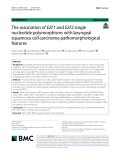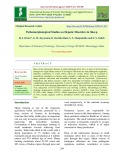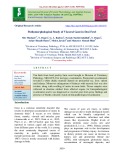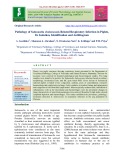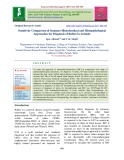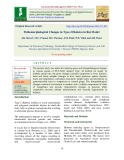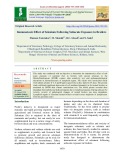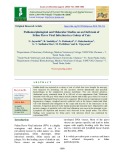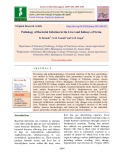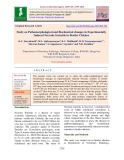
Pathomorphological studies
-
The current study aimed to evaluate the impact of four different single nucleotide polymorphisms (SNPs), E2F1 (rs3213183 and rs3213180) and E2F2 (rs2075993 and rs3820028), on LSCC development, morphological features, and patient 5-year survival rate.
 9p
9p  vikoch
vikoch
 27-06-2024
27-06-2024
 3
3
 1
1
 Download
Download
-
In addition, liver abscesses caused by bacterial septicaemia represent another major reason for meat condemnation (Tehrani et al., 2012). In these geographical areas, sheep husbandries mainly comprise nomadic practices and hence, etiologies responsible for sheep mortalities are often unknown or obscure.
 7p
7p  chauchaungayxua11
chauchaungayxua11
 23-03-2021
23-03-2021
 15
15
 1
1
 Download
Download
-
Ten birds from local poultry farm were brought to Division of Veterinary Pathology, SKUAST-J for necropsy examination. Postmortem examination revealed a white chalky material deposit on pericardial sac, liver, spleen and kidneys. Moreover enlargement of kidneys with necrotic foci was also evident, along with swelling of ureter in some birds. Tissue samples were collected in absolute alcohol from affected organs for histopathological examination and it was diagnosed as visceral gout from gross findings and presence of bluish coloured crystal on histopathological examination.
 4p
4p  cothumenhmong9
cothumenhmong9
 18-01-2021
18-01-2021
 9
9
 1
1
 Download
Download
-
The present study envisaged better understanding of isolation, identification and pathomorphology of S. choleraesuis in respiratory infections of piglets which will be helpful in adopting proper therapeutic modalities and initiating better control measures.
 8p
8p  cothumenhmong9
cothumenhmong9
 04-01-2021
04-01-2021
 12
12
 1
1
 Download
Download
-
To study the approach of immunohistochemistry (IHC) in comparison with study of pathomorphological alterations, for diagnosis of rabies, 50 brain samples from different animals like dog, cattle, buffalo and mongoose suspected for rabies were collected at post mortem hall. Out of the 50 animal brain samples tested, 30 (60%) were confirmed to be rabid by Fluorescent Antibody Technique (FAT). The 30 positive brain samples were subjected for comparison of histopathology and immunohistochemistry.
 6p
6p  kethamoi6
kethamoi6
 29-06-2020
29-06-2020
 14
14
 0
0
 Download
Download
-
The present study was aimed for studying gross and histopathological changes in various organs of STZ-NAD induced Type –II diabetic rat model. In diabetic group rats, the gross changes included congestion in liver, kidneys, heart and brain, atrophic changes in liver, heart, pancreas, spleen, thymus, testes and epididymes, edematous mesenteric lymph nodes and ulcerations in gastrointestinal tract in comparison to control group.
 6p
6p  angicungduoc5
angicungduoc5
 14-06-2020
14-06-2020
 16
16
 0
0
 Download
Download
-
This study was conducted with an objective to determine the immunotoxic effect of sub acute exposure of selenium (Se) in broilers with special reference to the Dinitroflurobenzene (DNFB) contact skin sensitivity test and pathomorphological alterations in histoarchitecture of lymphoid organs. The chicks were intoxicated orally with sodium selenite @ 2, 6 and10 ppm respectively in diet, daily for 35 days. The present study exhibited significant depression of cell mediated immunity in Se treated broilers as measured by DNFB skin contact sensitization test.
 7p
7p  trinhthamhodang1213
trinhthamhodang1213
 30-05-2020
30-05-2020
 6
6
 0
0
 Download
Download
-
Avian urolithiasis, or known as gout, is resultant to kidney damage from any of a number of potential cause, namely infectious or nutritional disease, ingestion of toxins, or a combination of factors. The present study reports pathomorphology of visceral Gout in commercial broiler chicken from Puducherry and Tamil Nadu region in India. A total of 120 kidney samples were collected for gross and histopathological examination. 24 (20%) samples showed gross changes of visceral gout. Microscopically, gout was recorded in 28 (23.33%) cases.
 5p
5p  trinhthamhodang5
trinhthamhodang5
 16-05-2020
16-05-2020
 9
9
 0
0
 Download
Download
-
Sudden death was reported in a colony of cats of which four were brought for necropsy with suspicion for poisoning. All the carcasses showed dehydration and petechial haemorrhages in the conjunctival mucous membrane. Two cats showed epistaxis. Abdominal cavity contained about 20 to 100 mL of sero-sanguineous fluid. Thickened intestinal wall with grey white mucus mixed contents and miliary grey white foci seen in the mucosa. Meningeal blood vessels were congested.
 7p
7p  chauchaungayxua5
chauchaungayxua5
 08-05-2020
08-05-2020
 14
14
 0
0
 Download
Download
-
Prevalence and pathomorphology of bacterial infection of the liver and kidneys was studied in swine population from postmortem carcasses of pigs in the Department of Veterinary Pathology, College of Veterinary science, Assam Agricultural University (AAU), Khanapara, Guwahati-22.A total of 21(48.8%) liver and 9(20.9%) kidney samples were found to be positive for the presence of bacterial infection out of 43 samples examined during the study. Bacteria isolated were mainly Streptococcus spp. (10.5%), Staphylococcus spp. (6.97%), Micrococcus spp. (1.16%), E. coli (11.6%), Klebsiella spp. (2.
 8p
8p  cothumenhmong3
cothumenhmong3
 22-02-2020
22-02-2020
 17
17
 0
0
 Download
Download
-
The present study was carried out in the Division of Veterinary Pathology, FVSC&AH, SKUAST-J R.S Pura, Jammu, to study the occurrence and mortality patterns associated with various pathological conditions in various parts of Jammu.200 flocks were surveyed in different areas in and around Jammu. Occurrence of colibacillosis (24.16%) was maximum followed by that of infectious bursal disease (IBD) (7.13%), omphalitis (6.79%), salmonellosis (5.36%). Other pathological or disease conditions found to be occurring in Jammu region were nonspecific enteritis (4.29%), coccidiosis (2.
 7p
7p  nguathienthan3
nguathienthan3
 27-02-2020
27-02-2020
 17
17
 0
0
 Download
Download
-
The present work was carried out to study the patho-morphological and biochemical changes in experimentally induced Necrotic enteritis in broiler chicken. Two experimental groups T1 & T2 each comprising of 40 day old female broiler chicks, were fed with normal feed on day 1 to 16. On day17th, 18th, 19th and 20th, they were orally administered with Clostridium perfringens at the dose rate of 4X108 CFU per bird thrice a day along with 10 times the dose of Livacox vaccine on day18th then from day 21 to 42 normal feed was fed to both the groups.
 16p
16p  nguaconbaynhay1
nguaconbaynhay1
 04-12-2019
04-12-2019
 11
11
 0
0
 Download
Download
CHỦ ĐỀ BẠN MUỐN TÌM









